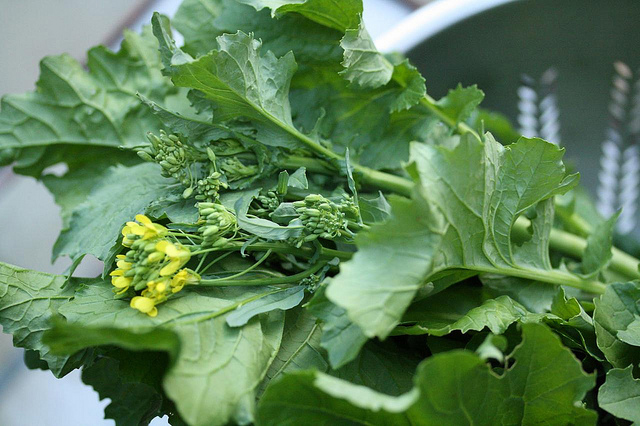Also known as rapini, rabe, and turnip broccoli, broccoli raab is a traditional Italian green with sharp flavored shoots topped by small bud clusters. It is another member of the vast cabbage family, and although it is a distant cousin to the familiar grocery-store broccoli, it is more closely related to the turnip.
Like other brassicas, it is a cool-weather vegetable, flourishing in the spring and fall gardens. It can even be grown under protection in late winter (by direct-sowing the seed in a cold frame or a polytunnel in late February) as well as in mid-autumn for overwintering.
Broccoli raab is very quick growing, often maturing in as little as 45 days (although 60 days is more typical, especially during the cooler months). It’s also compact and takes up little space in the garden, making it an ideal choice for a cold frame or a small garden.
PLANTING
Before planting, apply about an inch of compost or aged manure to the soil, along with a sprinkling of alfalfa meal to boost nitrogen levels.
Spring
The first seeding of the year can take place in an empty area of the cold frame or mini hoop tunnel in early spring (early April for us). Broccoli raab can be direct-seeded in the open garden about a month before the last spring frost or started indoors 6 to 7 weeks before the last frost and moved outside a month later.
The ideal soil temperature is 60 to 65°F (15–18°C), so don’t be tempted to sow the seeds too early, when the soil is wet and cold. Plant the seed ¼ to ½ inch deep and 2 inches apart in the garden bed. Keep rows about a foot apart.
Move transplants into the garden a month before the last spring frost, setting them about an inch deeper than they were in their pots and 4 to 6 inches apart. Toss a row cover over the bed if a hard frost threatens.
Summer
For a continuous crop, keep sowing fresh seed or planting more seedlings in the garden every few weeks. For summer crops, look for varieties that are bolt resistant, or plant them in the partial shade of a taller crop.
Fall/Winter
In late summer, start sowing fall varieties, and continue to plant more seed until mid-autumn. At this point, you can switch back to cold-frame production for a late-autumn to midwinter harvest. Although the plants can take some light frost, you can also lay a row cover over garden crops in mid-autumn to extend the harvest by protecting against a hard freeze or dipping nighttime temperatures.
GROWING
If you direct-seeded in the garden, you’ll have to thin the bed once the plants are about 4 inches tall. Ideally, the plants should be spaced 4 to 6 inches apart. Add the thinnings to a salad.
Brassicas appreciate consistent moisture, so keep plants watered if there is no rain. Also, watch out for typical brassica pests cabbage worms and flea beetles and use an insect-barrier row cover if these insects are an annual problem where you garden.
HARVESTING
Th e harvest will begin in about 60 days, although summer crops will often be ready in as little as 45 days. When the plants are 8 to 10 inches tall, with tight bud clusters, harvest the leaves and stalk, leaving a small stub in the soil. If you water the stub and apply a liquid fish fertilizer, you will often be rewarded with a second harvest in a few weeks. You can also pick just the budded stems, leaving the foliage to keep producing more bud clusters.
Th e pungent flavor of broccoli raab is best tamed with a quick blanch in boiling water, then a quick sauté with olive oil and garlic an essential part of a traditional Italian feast.


